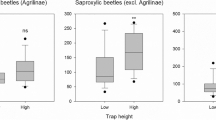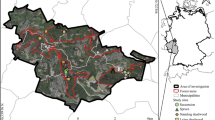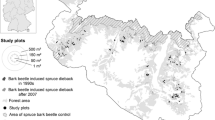Abstract
Understory plants are an important element of forests, having a considerable influence on ecosystem functioning and canopy-tree development following disturbance. Recent bark beetle outbreaks across western North American forests have caused extensive canopy mortality, creating new growing conditions that provide the opportunity for changes within the intact understory. Over a five-year period following peak mountain pine beetle (MPB) activity across lodgepole pine-dominated forests in Rocky Mountain National Park, Colorado, we measured the changes in plant diversity, cover, and dominance by lifeform and quantified tree regeneration rates. Average species richness and diversity increased, but overall plant cover did not change. Graminoids appeared to benefit the most, increasing in average cover, richness, and relative dominance. The rise in graminoid dominance was largely at the expense of shrubs, which showed little ability to benefit from overstory mortality within the first years following attack. Most plant responses were positively related to the total tree basal area lost since the peak of the outbreak, suggesting that increased resource availability following tree death may benefit understory plants. However, a negative relationship between several understory variables and tree sapling density provides evidence that understory plants compete with saplings for the newly available resources. Tree seedling density nearly doubled over the duration of the study, indicating a strong regeneration pulse. Among species, lodgepole pine displayed the greatest tree seedling establishment. This is one of the first studies to use repeated measurements to describe this often-overlooked component of forest change associated with MPB disturbance.



Similar content being viewed by others
References
Alaback PB, Herman FR (1988) Long-term response of understory vegetation to stand density in Picea-Tsuga forests. Can J For Res 18:1522–1530. https://doi.org/10.1139/x88-233
Aoki CF, Romme WH, Rocca ME (2011) Lodgepole pine seed germination following tree death from mountain pine beetle attack in Colorado, USA. Am Midl Nat 165:446–451. https://doi.org/10.1674/0003-0031-165.2.446
Astrup R, Coates KD, Hall E (2008) Recruitment limitation in forests: lessons from an unprecedented mountain pine beetle epidemic. For Ecol Manag 256:1743–1750
Barbier S, Gosselin F, Balandier P (2008) Influence of tree species on understory vegetation diversity and mechanisms involved-a critical review for temperate and boreal forests. For Ecol Manag 254:1–15. https://doi.org/10.1016/j.foreco.2007.09.038
Barton K (2015) MuMIn: Multi-Model Inference. R package version 1.15.6. https://CRAN.R-project.org/package=MuMIn
Binkley D (2008) Age distribution of aspen in Rocky Mountain National Park, USA. For Ecol Manag 255:797–802
Burnham KP, Anderson DR (2001) Kullback-Leibler information as a basis for strong inference in ecological studies. Wildl Res 28:111–119
Chao A, Jost L (2015) Estimating diversity and entropy profiles via discovery rates of new species. Methods Ecol Evol 6:873–882. https://doi.org/10.1111/2041-210X.12349
Clow DW, Rhoades C, Briggs J et al (2011) Responses of soil and water chemistry to mountain pine beetle induced tree mortality in Grand County, Colorado, USA. Appl Geochem 26:S174–S178. https://doi.org/10.1016/j.apgeochem.2011.03.096
Coll L, Balandier P, Picon-Cochard C et al (2003) Competition for water between beech seedlings and surrounding vegetation in different light and vegetation composition conditions. Ann For Sci 60:593–600
Collins BJ, Rhoades CC, Hubbard RM, Battaglia MA (2011) Tree regeneration and future stand development after bark beetle infestation and harvesting in Colorado lodgepole pine stands. For Ecol Manag 261:2168–2175. https://doi.org/10.1016/j.foreco.2011.03.016
Diskin M, Rocca ME, Nelson KN et al (2011) Forest developmental trajectories in mountain pine beetle disturbed forests of Rocky Mountain National Park, Colorado. Can J For Res 41:782–792. https://doi.org/10.1139/x10-247
Edburg SL, Hicke JA, Brooks PD et al (2012) Cascading impacts of bark beetle-caused tree mortality on coupled biogeophysical and biogeochemical processes. Front Ecol Environ 10:416–424. https://doi.org/10.1890/110173
Edwards M, Krawchuk MA, Burton PJ (2015) Short-interval disturbance in lodgepole pine forests, British Columbia, Canada: understory and overstory response to mountain pine beetle and fire. For Ecol Manag 338:163–175. https://doi.org/10.1016/j.foreco.2014.11.011
Frank JM, Massman WJ, Ewers BE et al (2014) Ecosystem CO2/H2O fluxes are explained by hydraulically limited gas exchange during tree mortality from spruce bark beetles. J Geophys Res Biogeosci 119:1195–1215. https://doi.org/10.1002/2013JG002597
Gelman A (2008) Scaling regression inputs by dividing by two standard deviations. Stat Med 27:2865–2873. https://doi.org/10.1002/sim.3107
Gilliam FS (2007) The ecological significance of the herbaceous layer in temperate forest ecosystems. Bioscience 57:845–858. https://doi.org/10.1641/B571007
Gray AN, Spies TA (1997) Microsite controls on tree seedling establishment in conifer forest canopy gaps. Ecology 78:2458–2473. https://doi.org/10.2307/2265906
Griffin JM, Turner MG (2012) Changes to the N cycle following bark beetle outbreaks in two contrasting conifer forest types. Oecologia 170:551–565. https://doi.org/10.1007/s00442-012-2323-y
Griffin JM, Turner MG, Simard M (2011) Nitrogen cycling following mountain pine beetle disturbance in lodgepole pine forests of Greater Yellowstone. For Ecol Manag 261:1077–1089. https://doi.org/10.1016/j.foreco.2010.12.031
Hawkins CDB, Dhar A, Balliet NA (2013) Radial growth of residual overstory trees and understory saplings after mountain pine beetle attack in central British Columbia. For Ecol Manag 310:348–356. https://doi.org/10.1016/j.foreco.2013.08.035
Hill MO (1973) Diversity and evenness: a unifying notation and its consequences. Ecology 54:427–432. https://doi.org/10.2307/1934352
Hubbard RM, Rhoades CC, Elder K, Negron J (2013) Changes in transpiration and foliage growth in lodgepole pine trees following mountain pine beetle attack and mechanical girdling. For Ecol Manag 289:312–317. https://doi.org/10.1016/j.foreco.2012.09.028
Jenkins ML (2015) Major forest insect and disease conditions in the United States 2013. USDA Forest Service [FS-1054], Washington, DC
Klutsch JG, Negrón JF, Costello SL et al (2009) Stand characteristics and downed woody debris accumulations associated with a mountain pine beetle (Dendroctonus ponderosae Hopkins) outbreak in Colorado. For Ecol Manage 258:641–649. https://doi.org/10.1016/j.foreco.2009.04.034
Kovacic DA, Dyer MI, Cringan AT (1985) Understory biomass in ponderosa pine following mountain pine beetle infestation. For Ecol Manag 13:53–67. https://doi.org/10.1016/0378-1127(85)90005-2
Larsen JB (1995) Ecological stability of forests and sustainable silviculture. For Ecol Manag 73:85–96. https://doi.org/10.1016/0378-1127(94)03501-M
McCambridge WF, Morris MJ, Edminster CB (1982) Herbage production under ponderosa pine killed by the mountain pine beetle in Colorado. USDA, Forest Service, Rocky Mountain Forest and Range Experiment Station [Research note RM-416], Fort Collins, CO, US
McIntosh ACS, Macdonald SE (2013a) Short-term resistance of ecosystem properties and processes to simulated mountain pine beetle attack in a novel region. Ecosphere 4:1–28. https://doi.org/10.1890/Es12-00344.1
McIntosh ACS, Macdonald SE (2013b) Potential for lodgepole pine regeneration after mountain pine beetle attack in newly invaded Alberta stands. For Ecol Manag 295:11–19. https://doi.org/10.1016/j.foreco.2012.12.050
McKenzie D, Halpern CB, Nelson CR (2000) Overstory influences on herb and shrub communities in mature forests of western Washington, USA. Can J For Res 30:1655–1666
McMillin JD, Allen KK (2003) Effects of Douglas-fir beetle (Coleoptera: Scolytidae) infestations on forest overstory and understory conditions in western Wyoming. West North Am Nat 63:498–506
Meddens AJH, Hicke JA (2014) Spatial and temporal patterns of Landsat-based detection of tree mortality caused by a mountain pine beetle outbreak in Colorado, USA. For Ecol Manag 322:78–88. https://doi.org/10.1016/j.foreco.2014.02.037
Meddens AJH, Hicke JA, Ferguson CA (2012) Spatiotemporal patterns of observed bark beetle-caused tree mortality in British Columbia and the western United States. Ecol Appl 22:1876–1891. https://doi.org/10.1890/11-1785.1
Muller RN (2014) Nutrient relations of the herbaceous layer in deciduous forest ecosystems. In: Gilliam FS (ed) The herbaceous layer in forests of eastern North America, 2nd edn. Oxford University Press, New York, pp 13–34
Nakagawa S, Schielzeth H (2013) A general and simple method for obtaining R2 from generalized linear mixed-effects models. Methods Ecol Evol 4:133–142. https://doi.org/10.1111/j.2041-210x.2012.00261.x
Nelson KN, Rocca ME, Diskin M et al (2014) Predictors of bark beetle activity and scale-dependent spatial heterogeneity change during the course of an outbreak in a subalpine forest. Landsc Ecol 29:97–109. https://doi.org/10.1007/s10980-013-9954-1
North M, Oakley B, Fiegener R et al (2005) Influence of light and soil moisture on Sierran mixed-conifer understory communities. Plant Ecol 177:13–24
Norton U, Ewers BE, Borkhuu B et al (2015) Soil nitrogen five years after bark beetle infestation in lodgepole pine forests. Soil Sci Soc Am J 79:282–293. https://doi.org/10.2136/sssaj2014.05.0223
Oksanen J, Blanchet FG, Friendly M, et al (2015) vegan: Community Ecology Package. R package version 2.4–0. https://CRAN.R-project.org/package=vegan
Pec GJ, Karst J, Sywenky AN et al (2015) Rapid increases in forest understory diversity and productivity following a mountain pine beetle (Dendroctonus ponderosae) outbreak in pine forests. PLoS ONE 10:e0124691. https://doi.org/10.1371/journal.pone.0124691
Peet R (1981) Forest vegetation of the Colorado front range. Vegetatio 45:3–75
Peet RK (2000) Forests and meadows of the Rocky Mountains. In: Barbour MG, Billings WD (eds) North American terrestrial vegetation, 2nd edn. Cambridge University Press, Cambridge, pp 75–122
Pelz KA, Rhoades CC, Hubbard RM, Smith FW (2018) Severity of overstory mortality influences conifer recruitment and growth in mountain pine beetle-affected forests. Forests 9:536. https://doi.org/10.3390/f9090536
Perovich C, Sibold JS (2016) Forest composition change after a mountain pine beetle outbreak, Rocky Mountain National Park, CO, USA. For Ecol Manag 366:184–192
Pinheiro J, Bates D, DebRoy S, et al (2015) nlme: Linear and Nonlinear Mixed Effects Models. R package version 3.1–128. https://CRAN.R-project.org/package=nlme
Raffa KF, Aukema BH, Bentz BJ et al (2008) Cross-scale drivers of natural disturbances prone to anthropogenic amplification: the dynamics of bark beetle eruptions. Bioscience 58:501–517. https://doi.org/10.1641/B580607
Reed DE, Ewers BE, Pendall E (2014) Impact of mountain pine beetle induced mortality on forest carbon and water fluxes. Environ Res Lett 9:105004
Reid MS (1989) Response of understory vegetation to major canopy disturbance in the subalpine forests of Colorado. Master thesis, Department of Geography, University of Colorado, Boulder, Colorado, US
Renwick KM, Rocca ME, Stohlgren TJ (2016) Biotic disturbance facilitates range shift at the trailing but not the leading edge of lodgepole pine’s altitudinal distribution. J Veg Sci 27:780–788. https://doi.org/10.1111/jvs.12410
Rhoades CC, McCutchan JH, Cooper LA et al (2013) Biogeochemistry of beetle-killed forests: explaining a weak nitrate response. Proc Natl Acad Sci 110:1756–1760. https://doi.org/10.1073/pnas.1221029110
Romme WH, Knight DH, Yavitt JB (1986) Mountain pine beetle outbreaks in the Rocky Mountains: regulators of primary productivity? Am Nat 127:484–494. https://doi.org/10.1086/284497
Sibold JS, Veblen TT, Chipko K et al (2007) Influences of secondary disturbances on lodgepole pine stand development in Rocky Mountain National Park. Ecol Appl 17:1638–1655
Sibold JS, Veblen TT, González ME (2006) Spatial and temporal variation in historic fire regimes in subalpine forests across the Colorado Front Range in Rocky Mountain National Park, Colorado, USA. J Biogeogr 33:631–647. https://doi.org/10.1111/j.1365-2699.2005.01404.x
Smith JM, Hart SJ, Chapman TB et al (1980s) Dendroecological reconstruction of 1980s mountain pine beetle outbreak in lodgepole pine forests in northwestern Colorado. Écoscience 19:113–126
Stone WE, Wolfe ML (1996) Response of understory vegetation to variable tree mortality following a mountain pine beetle epidemic in lodgepole pine stands in northern Utah. Vegetatio 122:1–12. https://doi.org/10.1007/BF00052811
Teste FP, Lieffers VJ, Landhäuser SM (2011) Seed release in serotinous lodgepole pine forests after mountain pine beetle outbreak. Ecol Appl 21:150–162. https://doi.org/10.1890/09-1881.1
Theobald DM, Stevens DL, White D et al (2007) Using GIS to generate spatially balanced random survey designs for natural resource applications. Environ Manag 40:134–146. https://doi.org/10.1007/s00267-005-0199-x
Acknowledgements
We are grateful to Matt Diskin for conceiving the understory study, assisting with data collection in 2008, and contributing to development of the 2013 resampling scheme. We thank Kellen Nelson for his statistical assistance and discussions contributing to this manuscript and Paige Parry for providing helpful comments on a previous version of this manuscript. We also thank Phil Georgakakos, Rachel Ray, and Chris Deaderick for their help with field data collection and Rocky Mountain National Park staff for their logistical support.
Funding
This research was funded by the Rocky Mountain Conservancy and a McIntire–Stennis award to Colorado State University.
Author information
Authors and Affiliations
Corresponding author
Ethics declarations
Conflict of interest
The authors declare that they have no conflict of interest.
Additional information
Communicated by Kyle Palmquist.
Publisher's Note
Springer Nature remains neutral with regard to jurisdictional claims in published maps and institutional affiliations.
Electronic supplementary material
Below is the link to the electronic supplementary material.
Rights and permissions
About this article
Cite this article
Pappas, G.S., Tinker, D.B. & Rocca, M.E. Understory vegetation response to mountain pine beetle disturbance in northern Colorado lodgepole pine forests. Plant Ecol 221, 1293–1308 (2020). https://doi.org/10.1007/s11258-020-01082-5
Received:
Accepted:
Published:
Issue Date:
DOI: https://doi.org/10.1007/s11258-020-01082-5




